One of the many problems coffee farmers across the globe face is the lack of control over market price. When prices plunge, many end up selling their produce below the cost of production, making coffee farming economically unsustainable, not to mention emotionally grinding. If you combine that with the lack of government subsidies common to many countries and brutal interest rates on loans one starts to wonder how small farms are even feasible.
In 2013, Colombian coffee producers made headlines due to major strikes that led to fuel and food shortages, protester deaths and the army on the streets. The claim was that the government exposed farmers to the international market and volatile trade deals but didn’t invest in the agricultural sector so that they could face the competition. That’s where Raw Material comes in – a green coffee production and trading company committed to improve equitability along the supply chain.
Three years after the strikes Raw Material ran a widely popular Kickstarter campaign and got funding for the El Fénix project to develop an advanced community wet mill in Calarcá, Colombia. The project’s logic is simple. Better post-harvest processing improves cup quality significantly and gives farmers more control over the final product. Consistently better coffee means access to the specialty market, which rewards quality by paying premiums and where prices are more predictable. This leads to more money within the community, which means equals social and economical sustainability.
This is just the beginning. El Fénix will have a cupping lab and will be able to roast as well, welcoming coffee professionals from overseas to see how the project is working at first hand, thus creating closer connections within the supply chain. Raw Material estimates the first crop to achieve Specialty standards will be with the project’s backers in 2020 and, as one of them, we are very excited to follow the company’s updates and to know more about the Pink Bourbon lot destined for our roastery.
As we’ve extended the opportunity to back the project to our customers, we believe you should get to know what’s behind this amazing initiative too. That’s why we interviewed Raw Material’s director Matt Graylee, one of the main people responsible for making El Fénix possible. With such a deep insight into the supply chain, Matt’s interview is a true lesson in coffee. Editing it would feel like leaving out valuable information, so we decided to publish it in full. If good coffee takes time, a good read does too. Matt speaks about price volatility, access to capital, labour, planning and efficiency. These might not be “sexy” subjects as he puts it, but these are the things that really make a difference. Enjoy!
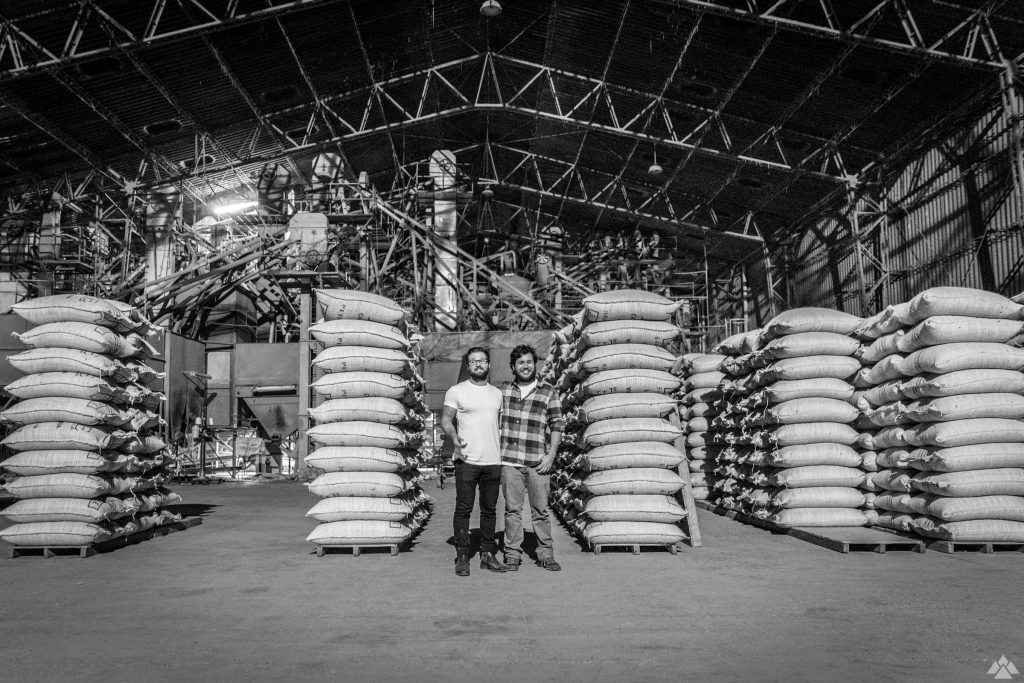
Matt and Miguel with sacks of coffee ready for export in Pitalito, Colombia (Photo: Raw Material)
Ancoats Coffee: What were RM’s motivations to start the El Fénix project?
Matt Graylee: El Fénix is a project that epitomises Raw Material’s goal. There is a widely understood systematic problem in traditional coffee supply chains that sees farmers receive low and volatile prices for their coffee. These market characteristics have grave consequences, directly for individuals and indirectly in broader society. At the same time, the popularity of coffee and the willingness to pay for it at the consumption end continues to grow. This second situation signals to us a partial solution to the first. Our purpose is to create stable and sustainable supply chains that generate opportunities for farmers and communities to create more value from their production. El Fénix is part of one of these supply chains, designed to fit the particular circumstance of the region.
Ancoats Coffee: How did you choose the location to put the project in place?
Matt Graylee: In our neighbourhood, the average coffee farming family generates a profit the equivalent of between £800 and £1,500/annum. This is after working a 1.5Ha plot producing approximately 3.5T of parchment, and is less income than would be created by family members each working any other minimum wage job. This is why people write about “the ageing population of coffee farmers”; this is a predictable response to incentives. Meanwhile, access to a market willing to pay slightly more opens up new options and opportunities. It was clear that supply to the specialty market would be positive for this region, and many others too. We spent half a decade in coffee producing countries running pilot programs, building community, and trialling many different elements that would become part of El Fénix. Calarcá arose as an excellent choice for our first big project. The community wet mill concept was unheard of here, and therefore new efficiencies were possible. The proximity to the airport is perfect considering our plan to include many roasters from overseas, and the location also meets the standard requirements; altitude, soil, rainfall, aspect, and sunshine hours.
Ancoats Coffee: Was the area facing particular problems or with very little access to the market
Matt Graylee: Calarcá isn’t an area facing difficulties any more strenuous compared with other regions, or most other countries. In fact compared to many producing countries productivity is high and the institutions are somewhat robust. Rather, the difficulties Calarcá faces are those most ubiquitous and consequential. Price volatility creates a situation whereby producers have an incentive to invest as little as possible in farm management and agricultural practices. This is a logical course of action. If the price that parchment coffee can be sold for moves around throughout the season (at times dropping below the cost of production, as it did all across Colombia in 2012 through 2013), then lowering the cost of production to the absolute minimum is a sound risk-mitigating action. However, minimising costs of production has visible adverse flow-on effects in both the short and long terms, e.g. diminishing productivity as fertilisation is reduced, the discovery of the price floor for farm employees, and disease outbreaks due to lack of preventive action. A better solution is access to a market which will welcome a stable price model
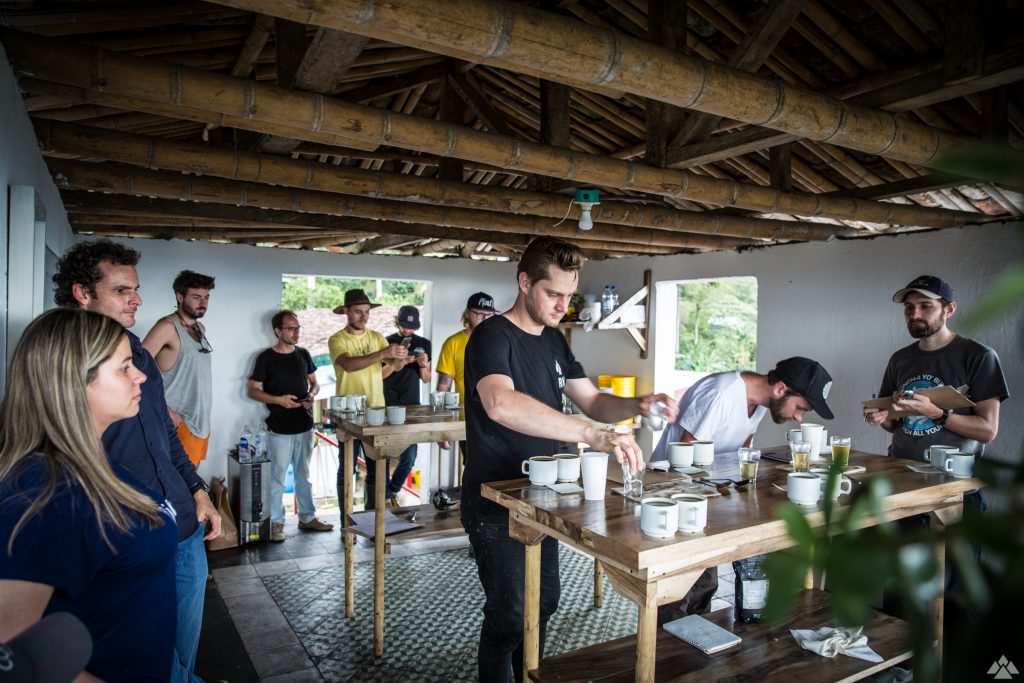
Richard (centre) and colleagues assessing coffee quality at our farm El Fénix in Calarcá, Colombia (Photo: Raw Material)
Ancoats Coffee: How long did it take to develop this project and put it into practice?
Matt Graylee: The concept behind El Fénix was years in the making. It has roots in a project from 7 years ago, before RM existed, called Helena. I met Miguel, now our business partner in RM, while we worked together to transform a commodity producing coffee farm into one which was able to cultivate specialty grade coffees. We achieved our goal to improve quality of the coffee from about 75 points to 83 points. Subsequently, Helena was profitable during the Colombian coffee riots of 2012, while coffee prices in the traditional market sunk and dragged along far below the cost of production. Because we commercialised directly, Helena was the only commercially successful farm in the region across that period.
The stark contrast of Helena’s situation compared with our neighbourhood’s posed a big question. Could a door to the specialty market be opened for the hundreds of other farms around us? How could the transition costs be minimised and risks mitigated to the point that would produce a significant impact, i.e. how could the development be scaled efficiently? Hundreds of Helenas approached in the same way would never work…
The answer we eventually developed is El Fénix community wet mill. We identified our most likely aligned supporters and had feedback sessions about the funding details. We chose Kickstarter as the medium for facilitating the funding last: the request and the rewards framework was already in place and tested with a representative community months before we determined Kickstarter would be the avenue. Upon launch, a >300 strong community of roasters and coffee enthusiasts around the world chipped in cash in advance, and made this possible.
Ancoats Coffee: Which are the main difficulties faced by local farmers? Which basic resources do they lack to produce better coffee and make a profit from it?
Matt Graylee: Environmental change is part of the concern. Prolonged rainy periods have heavily affected the harvest season. This results in many producers no longer able to dry their harvests using their traditional setup. Investment in improved drying facilities can solve this, but therein lies the first major hurdle: access to capital is extremely limited. Borrowing comes at a rate of interest you’d first recognise as a high, mistaking it for an annual rate, then as an absurdity as you realise this is a monthly cost. This has created a wet-selling scenario. Intermediaries have stepped in to purchase the pulped and washed wet coffee, carrying out the drying step, passing a portion of the dry parchment profit to growers. Coffee produced this way is at an increased risk of becoming defective.
For those still able to process fully at their farm, the fluctuating market available continues to provide low and volatile prices for the coffee produced. Access to the specialty market hindered by a lack of infrastructure at the individual farms, which is where the prospect of a community wet mill can prove itself most useful. Instead of many separate investments in infrastructure, knowledge acquisition, experimentation, and labour, this is all available in one space designed for the task. The community wet mill makes controlling variables throughout processing possible for the all farms in the region. This ensures the best cup quality can be discovered in the cherries’ potential. This also allows for a stable price to be offered up-front, reducing reliance on high-interest loans. Finally, at El Fénix, growers and roasters are cupping alongside each other, opening the door to the new market.
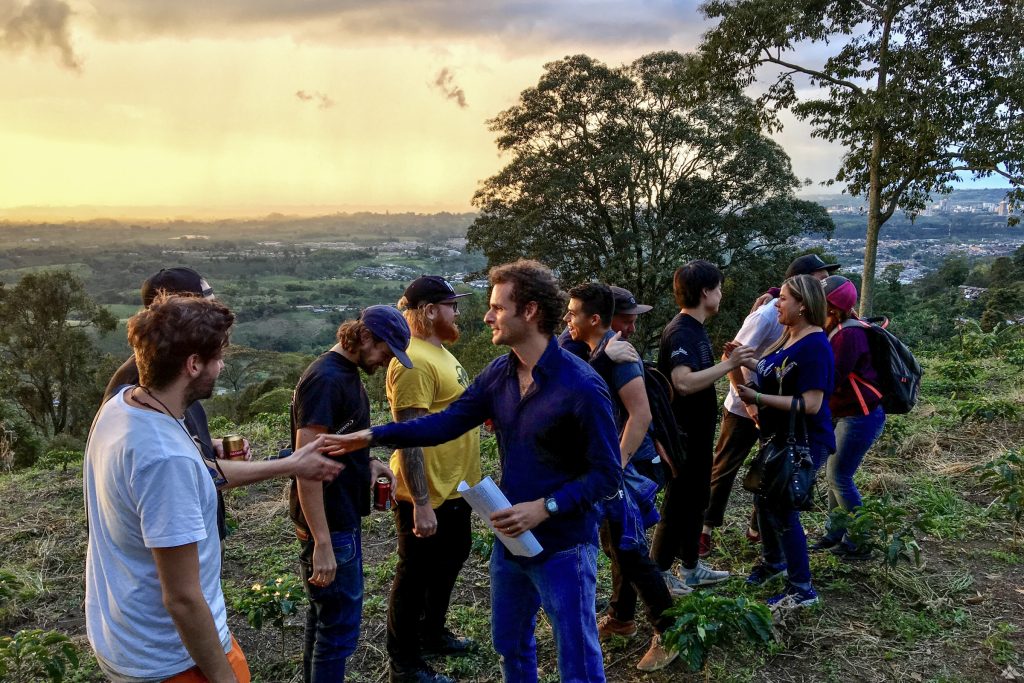
Prices being agreed between the original growers and the final buyers following the quality assessment carried out together (Photo: Raw Material)
Ancoats Coffee: Were you inspired by similar projects in different areas?
Matt Graylee: The general concept of a community wet mill is standard in other coffee producing countries, however not usually combined with a fixed-price-augmented-by-quality model. The multitude of little controls and surprises in the mill design are the culmination of visiting hundreds of farms across dozens of countries, and some direct suggestions from our friends at the CQI (Coffee Quality Institute).
The numerous results-driven, economically viable projects in the world motivate me. The Global Alliance for Improved Nutrition is an inspiration. Their food fortification programs have reached 800 million people in more than 30 countries around the world. Once an initial capital investment is made, continuing costs are only a few US cents per person per year. Food fortification helps economies by reducing malnutrition, preventing estimated losses to the economy of as much as 2.65% of GDP according to the World Bank: a sustainable system that is proven effective.
An example of a successful alliance for micronutrients is the GAIN-UNICEF Universal Salt Iodization Partnership, working in 14 countries from 2008-2015. This project protected an additional 466 million people against iodine deficiency, including an estimated 18.2 million pregnant and lactating women and 113 million children aged 6 months to 15 years old who are no longer at risk of its debilitating effects. I realise the scope difference is vast, but if we can explain a movement of the dial on these same issues using coffee as the tool, functioning in a self-sustaining manner through the competitive marketplace, then El Fénix and RM’s other projects can be considered successful. But it is early days, so, for now, we work and measure and think. Tweak and work and measure again.
Ancoats Coffee: Do you notice the project is being successful when you compare different harvests? What has had the biggest impact on cup quality as of yet? And what are the goals for the farm’s coffee?
Matt Graylee: Coffee quality has positively improved since beginning the project, even though we’ve been using only the old Castillo and temporary drying space up until now. We’ve gone from defective to 87 points, with the most dramatic impact coming from proper drying the storage. Now, all that Castillo is gone, replaced with the baby rare varieties like yours [the Pink Bourbon lot]. With the new controlled fermentation station, controlled drying rooms, and new varieties of cherries the goal is to win some quality competitions in the coming years while bringing up the quality of the entire region. We are aiming for extremely high scoring repeatable 95pt+ big-flip-the-massives through systematic, relentless experimentation and controls to counter heuristics.
Taking a risk in changing norms has the largest impact on both cup quality and producer’s bottom line. El Fénix is a complete setup that can serve the region, possible through replacing the standard practice of personal processing. Because El Fénix purchases cherry, we can control the variables that affect flavour throughout processing. This helps ensure high quality is achieved, and allows us to predict (and design to an extent) the resulting cup profile. Knowing that the resulting flavour will surpass the specialty coffee market’s threshold is also to identify the minimum price the green coffee can command. From here we can work back to find the maximum sustainable cherry price, with smaller buffers than other systems that do not have this information. This system results in a doubling of household incomes on average compared with selling parchment in the regular market. However, because selling dry parchment is the norm, adoption requires powerful communications and local champions of the idea.
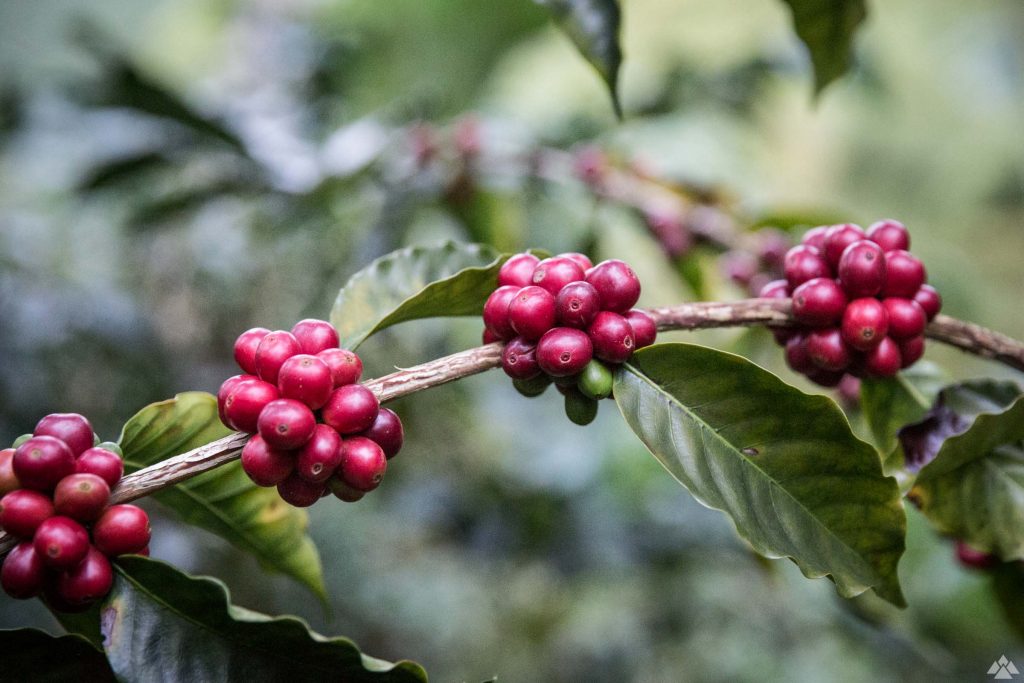
Coffee of the Gesha variety (originally from Ethiopia) ripening in Colombia (Photo: Raw Material)
Ancoats Coffee: Do you have an example of a farmer that is benefiting from the new set up?
Matt Graylee: We were pleasantly surprised by comments made recently by a farmer who now sells cherry instead of fully processing his harvest. He explained that while sceptical at first, he now loves selling cherry because it allows him to leave the house. “Slowly building up a stock of dry parchment is like leaving cash laying out in public.” he pointed out. He’s referring to the fact that as most people around us produce dry parchment, while buyers are everywhere and the price is broadcast widely (like an exchange rate), it is akin to a second currency. “Before I would have to wait weeks, watching the price fall as the coffee dried, stuck at home to secure it. These days I can sell the day I pick, pay my workers immediately, and relax with my family in the time I would have been processing in the past.”
Ancoats Coffee: Can you talk about the Pink Bourbon lot we are going to work with? Do you have a rough idea of what can be expected of it regarding cup profile?
Matt Graylee: Pink Bourbon from Colombia typically results in a very sweet, bright cup, with a more complex array of completing notes compared to the benchmark of the same farm’s production of a Caturra. This is based on what we’ve experienced so far at friend’s farms over the years. Combined with a sound yield, and reasonable nurture requirements, we chose this variety to compliment the farm’s overall risk vs potential profile as well as to meet some founder’s specific desires. With the pink bourbon, we plan on running trials using the miniature harvests coming up in the next 12 months to begin collecting data to better design the first proper harvest’s processing. We can trade in some of the complexity for a prominent, jammier flavour and mouthfeel. My hypothesis is that supporters would like to experience the full array of what the variety can bring in the first season. In answer to that will, we’ll aim for more than four processing styles and arrange them on a scale from which you can define the desirable traits. It is important to note also that our farm is new to hosting this variety, in fact, it is new to the whole road. So we don’t yet know definitively how the micro-climate, aspect, soil, and other elements will manifest in the cup; though we expect an increased tartaric acidity based on comparing other similar coffees across regions.
Ancoats Coffee: Could more people be involved in the project if they wanted to? How?
Matt Graylee: More people can get involved through the internships outlined on our website. Specifically economists. Come and visit us at the LCF if you are around and discuss what is happening. We have coffee from other projects available, and roaster memberships in our Red Associations are very beneficial and fun for everyone involved. It is all outlined at rawmaterial.coffee and elfenix.coffee.
Every year we select someone on our mailing list to come and learn first hand with us for ten days at El Fénix and across Colombia, all costs covered, even flights. That is a perfect (albeit extremely lucky) way to be involved and learn how everything works, from the ground up.
If you are a roaster, email me at matt@rawmaterial.coffee and ask questions. Samples? No problem. Want to visit during the season and cup with the team and the neighbourhood? Sure. Want us to model how your roastery would benefit from planned green coffee buying rather than spot purchases? Great, we love maths (and have built roasteries also so know the numbers). People can be involved in many ways, but the most helpful is through a commitment to using coffees from projects like these as they come to fruition. Knowing the market is there allows for planning. Planning means better resource allocation. It may not be sexy, but the adage is true: efficiency increases quality-adjusted life years.
Ancoats Coffee: Are there other projects in growing countries you believe more people should support?
Matt Graylee: We are part of a very ambitious project underway in Timor-Leste. Timor-Leste is ranked as the country most reliant on oil, with 95% of the government’s income generated through oil related income. The oil reserves producing this wealth will be dry in an estimated 2-5 years. Though oil funds the vast majority of public goods, most of the people living in Timor-Leste rely on coffee and other income streams. Coffee is the largest export after oil, and undoubtedly will become extremely important to the country’s well being as oil sources are depleted.
Transitioning to a robust coffee sector will take a vastly different approach to anything tried in the past considering the stakes, the extremely short time-frame, and the long list of NGO-backed industry improvement programs already underway or completed. As a proxy of industry strength, the average yield per hectare in Timor-Leste is less than 10% that in Colombia. The solution will not come easily, but it needs to happen quickly.
If you’d like to be involved or be the first to hear about what is happening there, please email timor@rawmaterial.coffee.
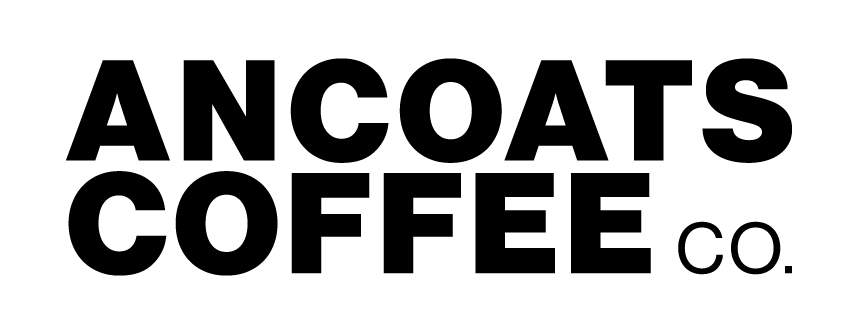
Trackbacks/Pingbacks